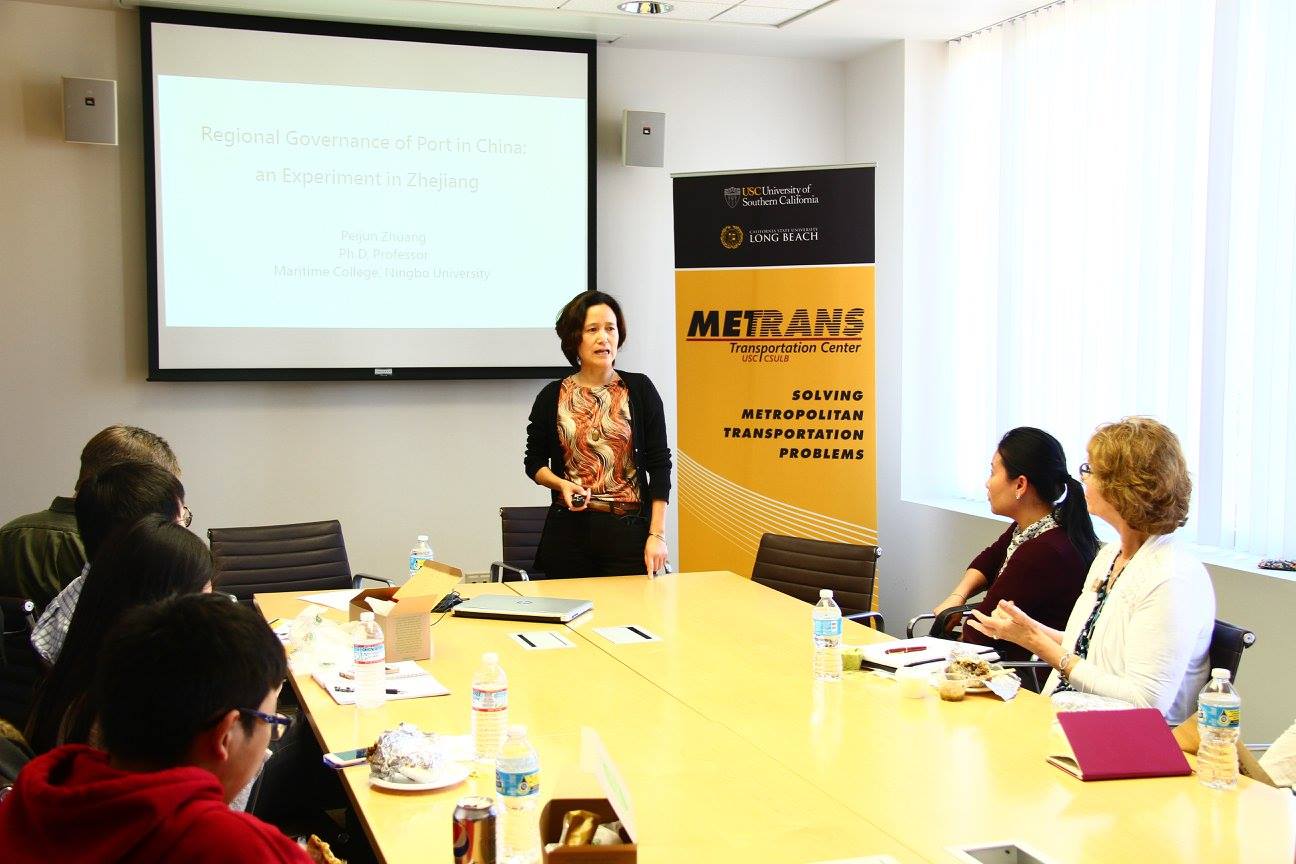News | Regional Governance of a Port in China
Stop the VideoNews

by By Kenan Zhang, USC MPP 2017
 On Wednesday, March 9th, METRANS welcomed a special guest, Professor Paige Zhuang, to deliver a speech on her research “Regional Governance of a Port in China,” to students, faculty, and practitioners at the University of Southern California. This presentation is part of the METRANS research seminar series, an ongoing series of presentations designed to share cutting edge transportation research with interested parties throughout the industry. All seminars are offered free of charge and are open to the public. Zhuang is currently a visiting scholar at California State University Long Beach and a professor at Maritime College, Ningbo University, China.
On Wednesday, March 9th, METRANS welcomed a special guest, Professor Paige Zhuang, to deliver a speech on her research “Regional Governance of a Port in China,” to students, faculty, and practitioners at the University of Southern California. This presentation is part of the METRANS research seminar series, an ongoing series of presentations designed to share cutting edge transportation research with interested parties throughout the industry. All seminars are offered free of charge and are open to the public. Zhuang is currently a visiting scholar at California State University Long Beach and a professor at Maritime College, Ningbo University, China.
Zhuang’s research focuses on the evolution of port locale and the relationship between ports in close proximity, using Ningbo Port as an example. She found that Chinese port location has been moving from inland river banks to the coast line and some ports are now located on or near islands in southern China. This shift is mostly due to changes in international trade and the large scale of shipping that fits better to port locations with open access to the ocean.
The governance of ports in China is highly influenced by historic locales and the development goals made by the central authority. Normally ports are governed by local authorities with the directory policy given the central government. However, Zhuang shared, one port on particular, Ningbo Port, has always been a focal point of trade development for the Chinese government. In this instance, there were direct policies from the central government aimed to increase the capacity at Ningbo Port. This led to a steady increase in port capacity over the past decade.
Zhuang also introduced a concept of “coopetition”, which means the ports within close range are actually working together and at the same time gain competence through cooperation. The Ningbo-Zhoushan port complex falls into this category. In 2006, the Chinese transportation department officially announced that Ningbo port and Zhoushan port will be referred as Ningbo-Zhoushan port complex. Through this “coopetition”, Ningbo-Zhoushan port complex has become the largest port in the world in terms of capacity. This idea was new to many of those in attendance at the seminar. USC MPL student, Sophia (Ganqing) Du, found the interaction relationship between Ningbo Port and Shanghai Port particularly interesting. The latter one is the largest single port in southeastern China. This dynamic relationship between ports has important implications on the policies that are targeting a single port, Zhuang noted.
During the discussion, the topic of port governance was then lead to the comparison of China and the U.S. Vincent (Yuzhe) Ying, also a USC MPL student, remarked that this is a very interesting concept. “It is true for ports in China and ports in the U.S. like the Los Angeles-Long Beach port complex,” he said. “It makes me think that the Ports of Los Angeles and Long Beach could cooperate to optimize supply chain management to increase efficiency and competence among the world’s ports.”
Kaitlyn (Kenan) Zhang
Kaitlyn is a first year MPP student at Sol Price School of Public Policy. Her interest is in transportation policy, urban development and public economics.
News Archive
- December (1)
- November (6)
- October (4)
- September (2)
- August (3)
- July (4)
- June (3)
- May (7)
- April (8)
- March (11)
- February (8)
- January (7)
- December (7)
- November (8)
- October (11)
- September (11)
- August (4)
- July (10)
- June (9)
- May (2)
- April (12)
- March (8)
- February (7)
- January (11)
- December (11)
- November (5)
- October (16)
- September (7)
- August (5)
- July (13)
- June (5)
- May (5)
- April (7)
- March (5)
- February (3)
- January (4)
- December (4)
- November (5)
- October (5)
- September (4)
- August (4)
- July (6)
- June (8)
- May (4)
- April (6)
- March (6)
- February (7)
- January (7)
- December (8)
- November (8)
- October (8)
- September (15)
- August (5)
- July (6)
- June (7)
- May (5)
- April (8)
- March (7)
- February (10)
- January (12)















